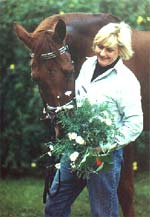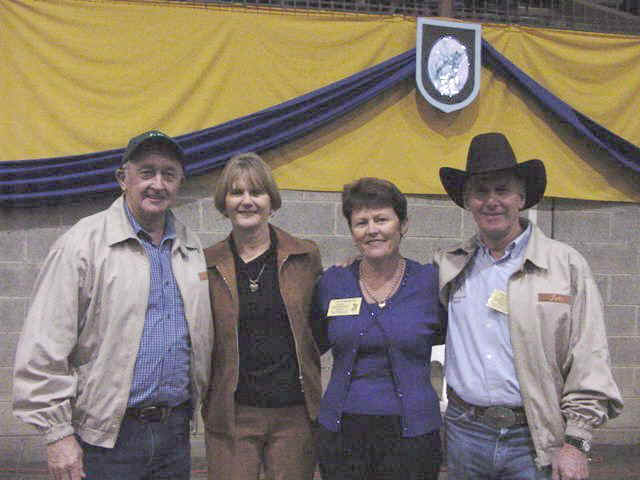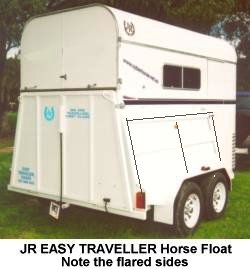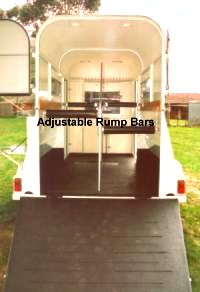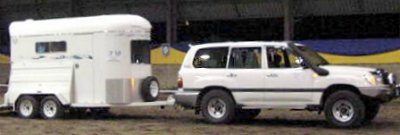| General News |
| HOW TO PREVENT TRAVEL STRESS By Victoria Ferguson Dip.Herb.Med., EFA Level 2
|
||||||
A horse which is showing some of these signs is a candidate for travel sickness/colic/laminitis which in severe cases can be fatal. Other less serious problems include tail rubbing and capped hocks. Obvious injuries are caused by excessive kicking sometimes accompanied by panic while a horse may not exhibit any obvious injuries but just be very sore & tired. Problems with loading and unloading are another area where stress often occurs and where injuries can occur. Reluctance to load and rushing off is usually a sign that the horse is not comfortable travelling. Or it may just be a sign that this area of training has been neglected or not carried out correctly. It is beyond the scope of this article to talk about training horses to load and unload properly so if you have problems seek assistance from one of the many experts in this area or get one of the self help books or videos.
Bach Flowers & Herbs Can Help Apart from good training Bach flowers & herbs can be used to reduce loading and travel stress. Usually Rescue Remedy and Chamomile tea will produce a good result in horses which are only mildly stressed. I recommend making up the Chamomile tea the day before. Use a good handful of Chamomile flowers to 300 mls of boiling water (about the size of a big coffee mug). Allow to sit for 15 minutes then strain & squeeze the rest of the liquid out of the dregs. Then add 10 drops of Rescue Remedy. Syringe 50 mls of the tea over the horse’s tongue at least one hour before loading and preferably before the horse has any idea about floats. Give another dose just before loading. Take the rest with you in case it is needed for the return journey. You should always use this mixture when training young horses to load and especially for the first few journeys. In fact you can use it as a general travel mix for short journeys. For longer journeys, make up Rosehips tea in the same way using 2 tablespoons of the granules and give it as well. Even if you are routinely feeding Rosehips, or Chamomile, you can still use the extra. For more nervous horses, extra Bach flowers should be added. Larch for confidence, Mimulus for fear, Scleranthus for balance and Cherry Plum for panic - add 5 drops each of these. Other nervine herbs should also be considered – Hops is a gentle relaxing herb and Vervain is especially relevant for horses that sweat up and or tremble. You can make up the tea for these in the same way. You can also add the tea or the dried herbs to the feed. Or you can get me to make you up a customised mixture using herbal extracts which is much easier as the dosage rate is very small and the herbs keep for much longer. For travel sickness, there are many herbs which hasten recovery in conjunction with veterinary care, but I need to prescribe these individually depending on the condition. Travel sickness is more likely to occur on longer journeys and apart from good driving and adequate stops for rest, watering and feeding, the best preventative is a naturally healthy horse with a well tuned immune system. This can be achieved by feeding a customised VF Natural Diet.
Vets Endorse JR Design Another effective way to reduce or eliminate travel stress is to invest in a JR Easy Traveller â float. Tests supervised by vets monitored 16 horses over several 4 day travel periods covering over 10,000 kms comparing the JR with conventional straight load design floats. Their findings were horses travelling in the JR had less dehydration, less weight loss, better heart & respiration rates, more normal temperatures and no travel sickness. It is also essential that travelling horses are able to put their heads down to clear airways. They can do this easily in a JR and they cannot do it at all in angle loads and some straight loads.
Designed by that great horseman John Chatterton and made in Queensland by Easy Traveller Trailers, the design is deceptively simple. The flared side walls provide extra space for horses to spread their legs for balance. The wider tailgate prevents horses stepping off the side of the tailgate which is often a cause of injury. The adjustable chest bars which move forwards or backwards depending on the length of the horse provides chest support, no bracing backwards on the front legs. The adjustable rump bars which move up and down, providing a space for the tail, prevent horses sitting back on the tailgate and provide rump support. Go to www.jr-easytraveller.com for more information about the JR
The wider wheel base and proper chassis provides a smooth ride, safe towing and better handling. I am the happy owner of a JR Easy Traveller Longreach (extended front) model and it has a lot of other design features which make it female user friendly. For example the tail gate is liftable with one hand, the jockey wheel is mounted on a swivel bracket so you don’t have to wrestle getting it on and off and it has recessed door handles so there is no chance of horses pulling back with halters caught in door handles. I tow two big horses with my Ford Explorer in this float legally & comfortably. Having owned a variety of floats in my life, including angle loads, I can safely say it is the best float I have ever owned. When one considers the amount of money horse owners spend on their horses, it makes sense to invest in a float which will prevent problems rather than create them. Victoria Ferguson http://www.herbalhorse.com |
||||||
Go to www.cyberhorse.net.au/safetowing for a
comprehensive |
||||||
| Featured Horse |
| Click | ||
| Featured Listing |
| Click | ||
| Featured Stallion |
| Click | ||
| Correspondents |
| Jenny Barnes Di Gatehouse Danny Boag Jan Heine Warren Lamperd Sarah Moss Mike Ogden Berni Saunders Dolly van Zaane |
| Click |
